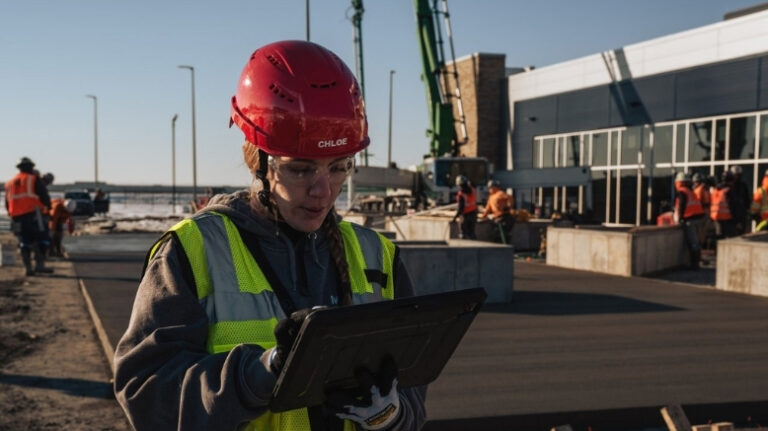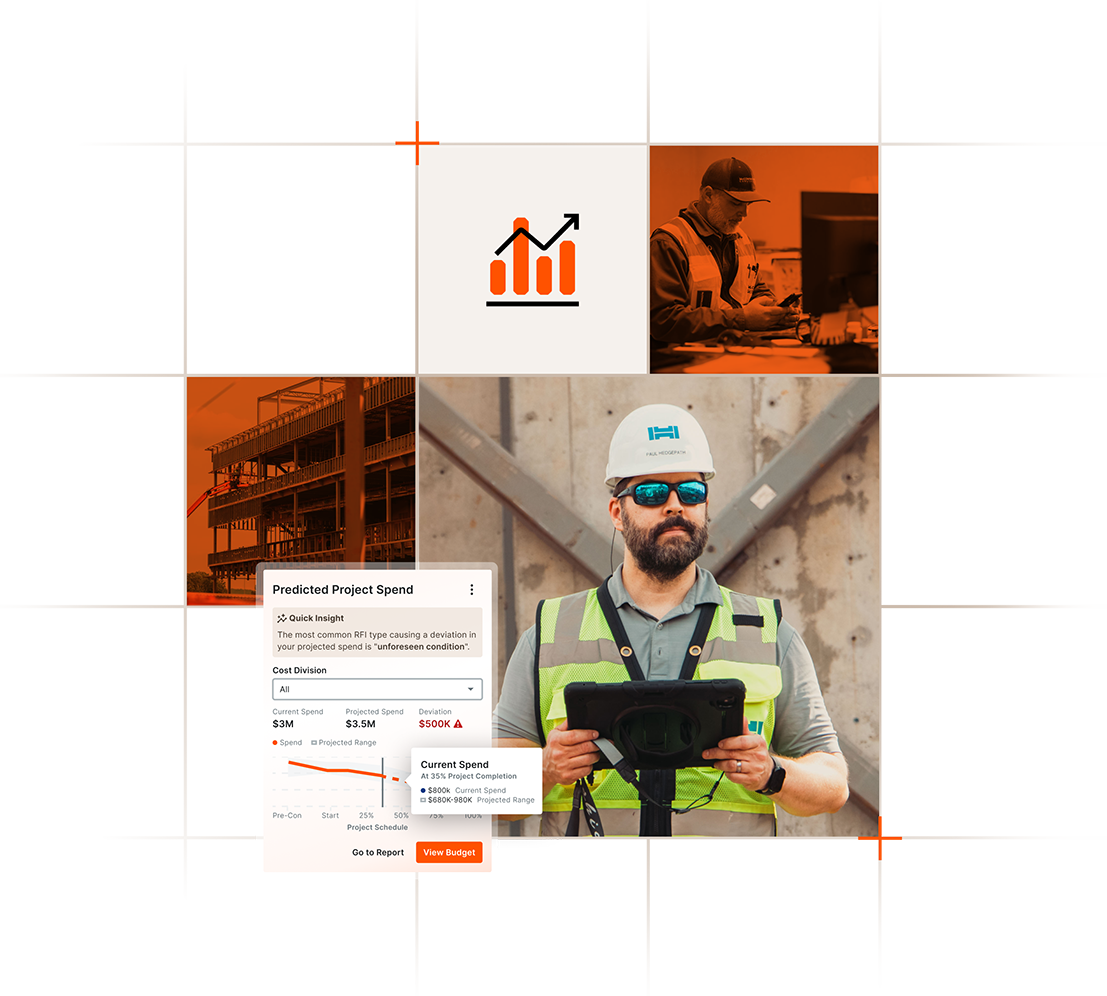— 6 min read
7 Strategies to Help Improve Construction Productivity

Last Updated Oct 3, 2025

Julia Tell
Contributing Writer
65 articles
Julia Tell is a freelance writer covering education, construction, healthcare, and digital transformation. She holds a Ph.D. in Media & Communications and has written for publications including Business Insider, GoodRx, and EdSurge, as well as nonprofits, international businesses, and educational institutions.
Last Updated Oct 3, 2025

Construction productivity has been dropping in recent years, exposing an opportunity for companies to improve outcomes by boosting productivity. The main drivers of productivity in construction are labor, materials and equipment.
By measuring and monitoring metrics with software, teams have the tools needed to figure out how to improve construction productivity by accurate planning, effective communication and setting ambitious but realistic productivity goals.
In this article we'll discuss the role of productivity in the construction industry — and look at seven key tips to equip industry professionals with the knowledge and tools to understand, measure and improve productivity on projects.
Table of contents
What is construction productivity?
Construction productivity is the measure of output achieved in relation to the input resources used in construction projects. This icludes the efficiency with which labor, materials and equipment are used to complete tasks within a project.
High productivity levels enable projects to be completed more quickly and with fewer resources, resulting in cost savings and increased profitability. Conversely, low productivity can result in delays, increased costs and potentially compromised quality.
According to an analysis by McKinsey & Company, construction productivity lags behind overall economic productivity and experienced a marked decline from 2020 to 2022. Another study of data shows that construction productivity peaked in the 1960s and has declined most notably since the 1990s.
With demand for new construction strong, input costs rising and a tight labor market, reversing the decline in productivity offers a possible pathway for a more profitable future for construction industry companies.
Productivity is the cornerstone of successful construction management, influencing key factors such as financial performance and quality. Boosting productivity in construction can lead to significant gains in on-time delivery and client satisfaction.
Types of Construction Productivity
There are four main types of productivity for construction management teams to consider when trying to increase productivity.
Labor
Labor productivity measures the amount of work completed per labor hour, highlighting the efficiency of the workforce. Improving labor productivity can lead to faster project completion and reduced labor costs.
Materials
Material productivity focuses on the efficient use of materials, assessing how much output is gained from the materials used. Effective material management can minimize waste and reduce costs.
Equipment
Equipment productivity evaluates the efficiency of the equipment used in construction, maximizing output while minimizing downtime by having all machinery operating at optimal capacity.
Total Factor Productivity (TFP)
TFP is a comprehensive measure that considers all inputs, including labor, materials, and equipment, to assess overall performance. TFP provides a holistic view of how resources contribute to project output, helping identify areas for improvement across the board.
How to Calculate Productivity in Construction
Calculating construction productivity involves assessing the work completed relative to the resources used, such as labor hours and materials. Construction benchmarking provides several methods for identifying areas for improvement. Setting clear project objectives and tracking specific metrics can help teams maintain focus and accountability.
Labor output is a primary construction key performance indicator (KPI), measuring efficiency by calculating the output per labor hour. This involves dividing the total amount of work completed, like square footage built, by the total labor hours. Another important metric is budget adherence, which compares actual costs with planned budgets to identify any cost overruns.
By consistently monitoring KPIs, project teams can boost both efficiency and accountability. For example, keeping an eye on labor output can identify areas for efficiency improvement, while observing task durations can pinpoint workflow bottlenecks. A structured approach can help teams drive continuous improvement throughout the project.
Earned Value Management (EVM) is a comprehensive approach that integrates project scope, cost and schedule measures to assess project performance. Within this framework, the productivity index is used to evaluate how efficiently resources are being used. A productivity index greater than one indicates that a project is ahead of schedule or under budget, while a value less than one signifies potential issues.
How Tech Improved Productivity for an Infrastructure Leader
Using construction management software allows Modigent, a leader in infrastructure construction, technology and energy solutions, to reduce closeout procedure time by 50%, resulting in approximately 40 hours of savings per project. Real-time access to financial data allows project managers to run projects without delays caused by payroll or payables processing.
Eliminating inefficiencies and consolidating data helped Modigent allocate labor and navigate supply chain disruptions more efficiently. The way Modigent has maximized and leveraged technology has created opportunities to get the most out of every one of their employees.
7 Proven Strategies to Help Boost Construction Productivity
Several construction industry issues impact productivity, ranging from workforce skills and motivation to the availability of materials and the effectiveness of project management techniques. Here are some best practices that teams can target to make productivity gains that help the bottom line:
1. Identify key drivers that impact productivity.
Each company or project may have a unique set of factors that decrease productivity.
On one project, weather issues and labor shortages may be the primary concerns, while supply chain delays and inexperienced project management might have the most significant impact on another. Assessing potential productivity snags with the most detrimental effect allows teams to focus their efforts on those areas.
2. Streamline workflows with preconstruction planning.
Early-stage planning reduces confusion and sets construction teams up for successful execution by providing clear direction and expectations.
Detailed scheduling, precise scope definition and thorough material planning increase site efficiency by minimizing delays and resource mismanagement. Getting input from multiple stakeholders and using collaborative software can increase the accuracy of plans.
Build a Strong Foundation with our Preconstruction Course
With 20+ years of experience, Ben Ashburn teaches you how to streamline planning, bidding, and procurement for better outcomes.

3. Set clear goals and track progress.
Tracking construction productivity with digital tools like time tracking apps, productivity dashboards and mobile project management platforms allows teams to monitor output and adjust quickly.
Setting clear goals provides a focused direction and measurable benchmarks for progress. Clarity helps teams prioritize tasks effectively, allocate resources effectively and achieve objectives on schedule.
4. Use technology to monitor and measure performance.
Easy access to data from construction management software gives teams the information they need to monitor progress and identify bottlenecks or problems that impact productivity. Other construction technologies that boost productivity — like building information modeling (BIM) or drones — provide additional precise data to assist planning, management and coordination among project teams.
5. Improve Field Communication and Collaboration
Poor communication can significantly hinder productivity, leading to misunderstandings, delays and costly errors and the need for rework.
Centralized digital construction collaboration platforms mitigate these issues by facilitating real-time communication, tracking changes and managing documentation efficiently, keeping all stakeholders informed and aligned throughout the project lifecycle.
6. Invest in ongoing training and skill development.
Training improves labor efficiency by giving workers the skills and knowledge to perform tasks accurately.
On-site skill development, including hands-on workshops and mentoring, allows workers to apply new techniques directly to their tasks. Digital training platforms can provide continuous learning opportunities through accessible courses and simulations. A commitment to upskilling makes employees feel valued, boosting morale and retention.
7. Reduce downtime with smarter resource allocation.
Aligning labor, equipment and materials with the project schedule minimizes idle time and prevents costly delays. Technologies like advanced scheduling software and predictive analytics tools enable accurate forecasting and real-time adjustments, helping to avoid bottlenecks by anticipating resource needs and streamlining operations.
Productivity Improvements = Project Improvements
Improving productivity in construction through more innovative and consistent work practices leads to faster project delivery, lower costs, fewer delays and ultimately, happier clients. '
Technology can support strategic planning, communication and continuous skill development to streamline processes and achieve excellence. Mitigating the factors that hinder construction productivity can boost project performance and position companies for long-term success and competitiveness in the market.
NOV 6, 2025 at 11:00 AM PST / 2:00 PM EST
Free Webinar: Prove your project management software is profitable
Join Procore and Dodge Data & Analytics for a 2025 Dodge ROI Report deep dive.

Was this article helpful?
Thank you for your submission.
0%
0%
You voted that this article was . Was this a mistake? If so, change your vote
Scroll less, learn more about construction.
Subscribe to The Blueprint, Procore’s construction newsletter, to get content from industry experts delivered straight to your inbox.
By clicking this button, you agree to our Privacy Notice and Terms of Service.
Thank you!
You’re signed up to receive The Blueprint newsletter from Procore. You can unsubscribe at any time.
Categories:
Written by

Julia Tell
Contributing Writer | Procore Technologies
65 articles
Julia Tell is a freelance writer covering education, construction, healthcare, and digital transformation. She holds a Ph.D. in Media & Communications and has written for publications including Business Insider, GoodRx, and EdSurge, as well as nonprofits, international businesses, and educational institutions.
View profileExplore more helpful resources

Capital Project Management: A Quick Guide for Construction Pros
With aging infrastructure and new technology needs, capital projects will remain a high priority for communities around the world in the coming years. Effectively managing capital construction projects is necessary...

Avoiding The App Trap: Overcome Financial Silos to Connect Field & Office
For general contractors working on razor-thin margins, rework and project delays are more than simple inefficiencies — they are major threats to the bottom line. For years, GCs have attempted...

Profit from Predictability: Construction Software as a Business Strategy
For general contractors, managing complex, multi-million-dollar projects, every project phase — from planning and budgeting to on-site execution — is an opportunity to lose time and money. Construction software is...

Defending Against Financial & Legal Risks on Megaprojects
The construction industry has seen marked growth in megaprojects. Some experts classify any project over $500 million as a megaproject, while others argue that the build needs to be $1...
Free Tools
Calculators
Use our calculators to estimate the cost of construction materials for your next project.
Templates
Find a template to help you with your construction project tasks.
Material Price Tracker
Get the latest U.S. retail prices and view historical trends for common building materials.
Glossary
Explore key terms and phrases used in the industry.
